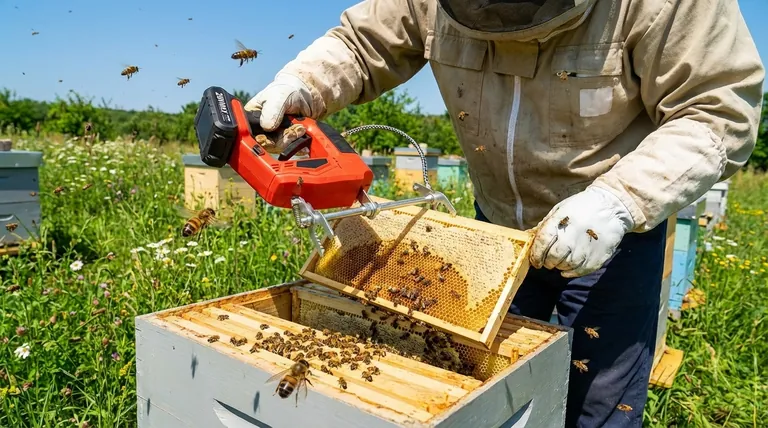Beyond their critical reproductive function, recent studies confirm that male honey bees, or drones, play a more active and beneficial role in the colony than previously understood. Far from being a simple drain on resources, drones contribute directly to the hive's internal environment and the physiological health of their sister worker bees.
The traditional view of drones as costly and unproductive is being replaced by a more nuanced understanding. Evidence now shows they are an integrated component of the colony's social fabric, actively contributing to thermoregulation and enhancing overall worker bee health.
The Traditional View: Drones as a Resource Cost
For decades, the prevailing wisdom in beekeeping centered on the high cost of raising and maintaining drones. This perspective is rooted in observable facts.
They Do Not Forage
Drones do not participate in foraging for nectar, pollen, water, or propolis. They perform no "external" work for the colony, such as guarding the entrance or scouting for resources.
They Consume Significant Resources
A drone's primary function inside the hive is to eat and conserve energy for mating flights. They are fed by worker bees until they mature and continue to consume large amounts of honey, placing a direct metabolic load on the colony's food stores.
Emerging Science: The Functional Roles of Drones
New research is revealing that the presence of drones provides tangible benefits that can offset their resource cost, contributing to the colony's function as a "superorganism."
Aiding in Colony Thermoregulation
Drones appear to play a role in maintaining the stable temperature of the brood nest (around 95°F or 35°C). Their large bodies can generate significant heat, and studies suggest they contribute to the collective effort of incubating the developing larvae, especially in the core of the brood area. This frees up worker bees for other critical tasks.
Enhancing Worker Bee Nutrition and Health
Perhaps the most significant finding is the effect of drones on worker bee physiology. Studies show that in colonies with a healthy drone population, worker bees have better-developed pharyngeal glands.
These glands are responsible for producing royal jelly, the protein-rich food fed to the queen and young larvae. More developed glands mean workers can produce higher quality food, leading to better-nourished brood and a more robust colony overall.
Understanding the Trade-offs: Balancing Drone Population
Viewing drones as purely beneficial is as inaccurate as viewing them as purely costly. An effective advisor understands the balance required for a healthy colony.
The Cost During a Nectar Dearth
While their benefits are clear, a large drone population can become a severe liability when forage is scarce. During a nectar dearth, the drones' high consumption rate can rapidly deplete a colony's winter stores, threatening its survival. Colonies will naturally expel drones in the autumn or during times of stress for this reason.
Drones as Vectors for Varroa Mites
This is the most critical trade-off in modern beekeeping. The Varroa destructor mite shows a strong preference for drone brood. The mite's reproductive cycle aligns perfectly with the longer development time of a drone pupa, allowing mites to produce more offspring in a drone cell than in a worker cell.
Therefore, an unmanaged drone population can act as a Varroa "mite bomb," leading to a rapid and devastating explosion of the mite population within the hive.
A Modern Approach to Drone Management
Your management strategy should reflect a nuanced understanding of the drone's dual role as both a contributor and a potential liability.
- If your primary focus is integrated pest management (IPM): Use the mites' preference for drone brood against them. Inserting a frame with a drone-sized foundation allows you to "trap" Varroa, which you can then remove and freeze before the drones emerge, significantly reducing the mite load.
- If your primary focus is raising strong, resilient colonies: Allow your bees to maintain a natural population of drones, especially in the spring and summer. The benefits to worker health and thermoregulation contribute to a stronger, more productive colony that is better equipped to handle stress.
- If your primary focus is maximizing honey production: Avoid complete drone eradication. While limiting excessive drone comb can conserve some resources, recognize that the improved worker health and brood nourishment from a modest drone population ultimately support the strong workforce needed for a large honey crop.
By understanding drones as functional members rather than simple resource drains, you can manage your colonies with greater precision and foresight.

Summary Table:
| Drone Role | Traditional View | Emerging Science |
|---|---|---|
| Resource Use | High consumer, non-forager | Contributes to hive thermoregulation |
| Colony Health | Seen as a liability | Enhances worker bee nutrition and royal jelly production |
| Management | Often discouraged | Key for IPM and raising resilient colonies |
Optimize your apiary's health and productivity with HONESTBEE. Our high-quality beekeeping supplies and equipment are designed for commercial apiaries and distributors focused on wholesale success. From durable hive components to effective IPM tools, we provide the reliable gear you need to implement modern management strategies. Let's build stronger colonies together—contact our team today to discuss your needs!
Visual Guide

Related Products
- High Performance Cordless Electric Bee Shaker for Beekeeping
- Professional Grade Foldable Beehive Handles
- Electric Flatting and Embossing Machine with Tray for Beekeeping
- HONESTBEE Heavy Duty All Metal Frame Wire Crimper Tool
- High Performance Plastic Queen Excluder for Beekeeping and Apiary Management
People Also Ask
- Why is it advised not to take honey in late summer? Ensure Your Colony's Winter Survival
- How does smoke affect bee behavior during hive inspections? Master the Smoker for Safer Inspections
- What is the purpose of using soap and suds on the roller? Ensure a Clean, Tear-Free Wax Sheet Release
- What are the benefits of using a bee smoker properly? Ensure Calm, Safe, and Productive Hive Inspections
- Why is a bee smoker essential? Master Safe & Efficient Hive Management



















